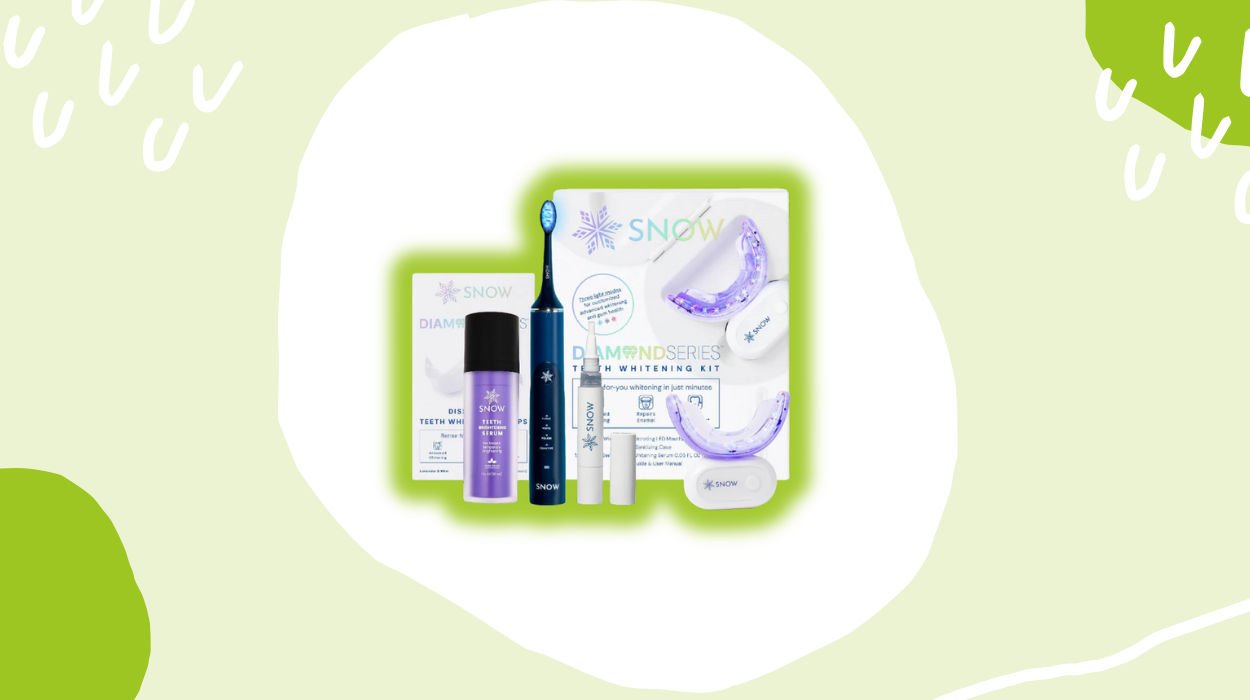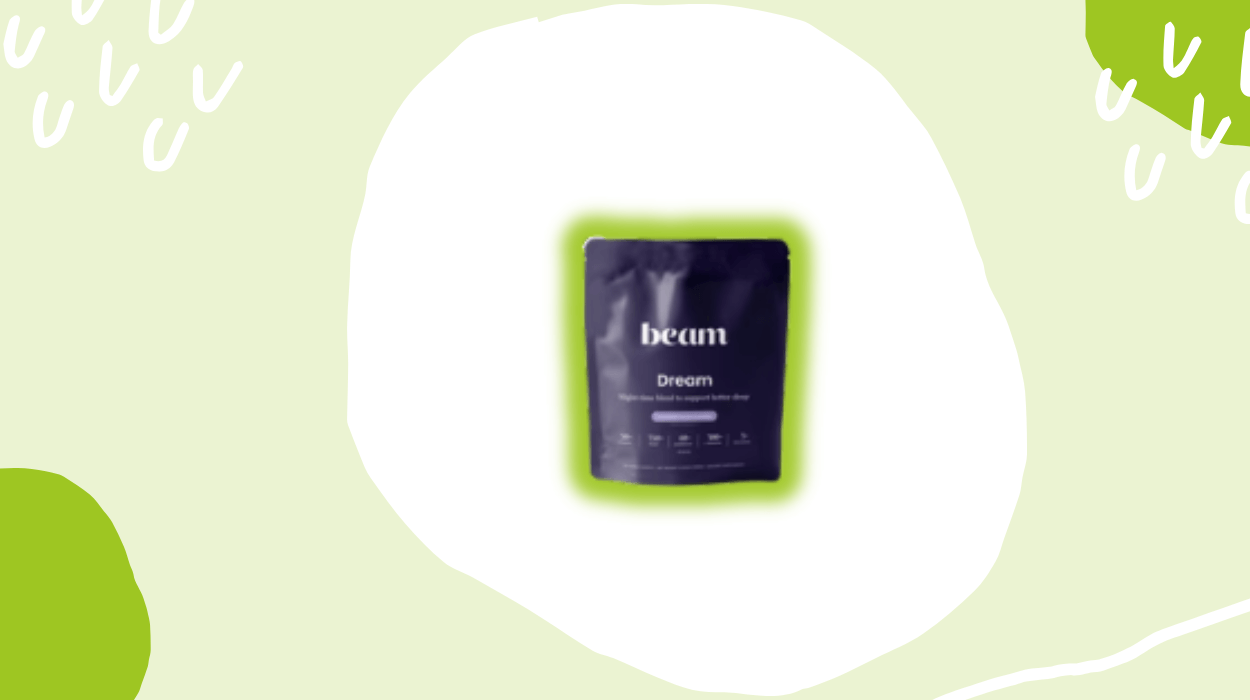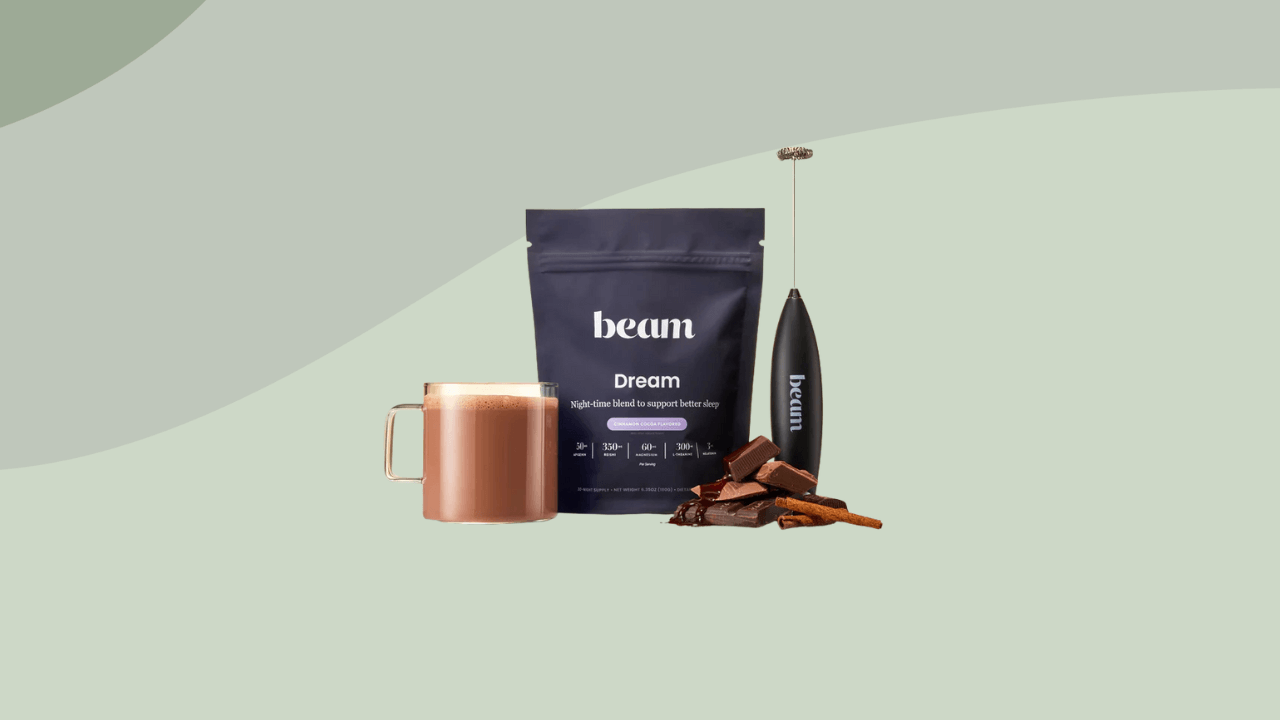

Beam Dream may support better sleep and relaxation. Intended to be mixed with warm milk or water, it provides calming effects and supports improved sleep quality.
Poor sleep can drain your energy, disrupt focus, weaken immunity, and increase the risk of mood disorders and chronic conditions like heart disease.
Beam Dream’s formulation might help support your circadian rhythm and calm your nervous system, potentially promoting restful sleep.
This article will cover the Beam Dream’s main ingredients, potential benefits, and side effects. We will also evaluate what real users have experienced with Beam Dream.
Beam Dream is a sleep-focused hot cocoa mix that supports nighttime relaxation. As per the official website, Beam Dream is available in different flavors such as Iced Cherry Berry, Original-Cinnamon Cocoa, Sea Salt Caramel, Chocolate Peanut Butter, Brownie Batter, Salty Dark Chocolate, or Blueberry Crumble.
Beam Dream might help you fall asleep faster and also stay asleep longer. It combines five natural sleep-supporting ingredients such as magnesium, apigenin, melatonin, L-theanine, and mushroom extract. Beam Dream claims to help regulate your sleep-wake cycle and reduce restlessness and muscle tension. It might also help promote relaxation and deeper sleep by easing stress.

Reishi mushroom (Ganoderma lucidum) is said to have calming and immune-modulating properties. It is believed to help regulate the hypothalamic-pituitary-adrenal (HPA) axis, which controls stress responses. Reishi may help reduce anxiety and promote relaxation by modulating cortisol levels, key precursors to restful sleep. Its bioactive compounds, such as triterpenes and polysaccharides, are thought to support neuroprotection and influence GABAergic signaling, a major inhibitory neurotransmitter system involved in sleep induction. Though not directly sedative like melatonin, Reishi’s adaptogenic effects may help improve sleep quality over time by calming your nervous system and reducing physiological arousal.
L-Theanine may help in promoting relaxation without causing drowsiness. It crosses the blood-brain barrier and enhances the production of GABA, dopamine, and serotonin, neurotransmitters that regulate mood and sleep. L-Theanine is also known to reduce excitatory neurotransmitter activity, such as glutamate, which can quiet brain activity and make it easier to fall asleep. Studies show that L-Theanine can increase alpha brain wave activity, a pattern which is associated with a relaxed yet alert state. This may help ease the transition into sleep, particularly if you have trouble shutting off mentally at night.
Iron is involved in oxygen transport and neurotransmitter synthesis. It is essential for the production of dopamine, a neurotransmitter that affects sleep–wake regulation. Iron is necessary for the proper functioning of enzymes involved in energy metabolism and neurological health. Iron deficiency can result in fatigue, poor sleep quality, and mood disturbances, all of which indirectly affect sleep architecture.
Apigenin is known as a naturally occurring flavonoid found in plants like chamomile, parsley, and celery. It could bind to benzodiazepine receptors in your brain, which are part of the GABA-A receptor complex. This interaction enhances the activity of GABA, which is the main inhibitory neurotransmitter in the central nervous system, resulting in sedative and anxiolytic effects. Because of its GABAergic activity, Apigenin might help reduce sleep latency and promote deeper, more restorative sleep. Apigenin’s action is more subtle, offering a calming effect without significant risk of dependency or morning grogginess. Its antioxidant properties may also contribute to better brain function, further supporting its role in sleep regulation.
The melatonin hormone plays a central role in regulating the circadian rhythm, your body's internal clock that dictates sleep–wake cycles. It signals to your brain that it’s time to wind down, helping initiate sleep. It may also help correct circadian misalignments, such as those caused by jet lag, shift work, or delayed sleep phase syndrome. Melatonin works primarily through MT1 and MT2 receptors in your brain, which help decrease alertness and prepare the body for sleep.
Magnesium might aid in nerve function, muscle relaxation, and neurotransmitter regulation. It supports sleep by modulating GABA receptors in the brain, helping calm neural activity and prepare the body for rest. Low magnesium levels could be related to poor sleep quality and nighttime awakenings. It might also help reduce cortisol levels and inflammation, both of which could interfere with sleep. Magnesium could promote melatonin synthesis, making it a key cofactor in maintaining a stable sleep–wake cycle.
Sodium helps regulate fluid balance, nerve function, and muscle contractions. It may help maintain homeostasis, which can influence sleep indirectly. Adequate sodium levels help ensure proper hydration and nerve signaling, both of which affect sleep quality. In some cases, low sodium levels (hyponatremia) can lead to symptoms like confusion, fatigue, and disrupted sleep.
As per the official website, Beam Dream works through its ingredient formulation, which contains components studied for their potential effect on sleep quality.
Beam Dream has apigenin, which binds to GABA-A receptors in your brain, helping calm mental chatter and reduce pre-sleep anxiety. The makers also added L-theanine in this formula, which might help promote alpha brain wave activity, associated with calm focus and mental tranquility, allowing you to transition smoothly into deeper relaxation without feeling groggy.
Magnesium in Beam Dream could help enhance this effect by regulating neurotransmitters that quiet the nervous system and by relaxing muscles, reducing tension that can interfere with falling asleep.
Beam Dream also combines reishi mushroom extract, which might support your body’s stress response by acting on the HPA axis to help moderate cortisol levels. This adaptogenic action may help create a more stable environment for restful sleep and reduce the likelihood of waking during the night.
Melatonin in Beam Dream could provide a clear biological signal to your circadian rhythm that it’s time to sleep. It might shorten the time it takes to fall asleep and promote a more consistent sleep-wake cycle by synchronizing your internal clock.
Beam Dream may help you recover and support a healthy sleep hygiene that could improve memory and mood. It may help develop conditions that allow your brain to rest and recover more effectively overnight.
According to the brand, Beam Dream supports restorative sleep, which might enhance your brain’s process of consolidating memories and regulating neurotransmitters involved in emotional balance.
Beam Dream may help stabilize your mood by reducing overactivity in the stress-response system that often leads to irritability or low motivation. It could help you wake up feeling more emotionally balanced and mentally clear by promoting uninterrupted rest.
Beam Dream might promote restorative sleep, allowing your body to naturally recharge overnight. It combines sleep-supportive ingredients like L-theanine that might encourage deeper stages of sleep, particularly slow-wave sleep (SWS) and REM sleep. These phases are biologically essential for energy restoration as SWS supports muscle repair, protein synthesis, and hormone release, while REM sleep aids in cognitive recovery and emotional regulation.
When your body gets enough of these restorative sleep stages, it’s better equipped to regulate glucose metabolism and mitochondrial efficiency, key processes that impact energy production throughout the day.
Beam Dream might help reduce morning grogginess and help sustain energy levels more evenly by helping you achieve longer and higher-quality sleep. You could experience waking up feeling refreshed, with fewer midday crashes and better resilience to daily mental and physical demands.
Beam Dream may support your immune system by improving the duration and quality of sleep, an essential factor in immune regulation. Deep sleep is when your body releases cytokines, the proteins that help regulate immune responses and fight off infection. If you're not sleeping well or long enough, your body may not produce enough of these immune-supporting molecules, leaving you more vulnerable to illness. Beam Dream could encourage healthier immune activity overnight, which means you may notice fewer colds, faster recovery times, improved wound healing, and more consistent energy throughout the day.
Beam Dream may aid in improving he quality of your sleep, which is essential for your body’s natural skin regeneration processes. While you sleep, your body increases the release of growth hormone, which stimulates collagen production, keeping your skin firm, elastic, and smooth. Beam Dream’s calming blend of ingredients like magnesium, L-theanine, and melatonin supports these deeper sleep phases, giving your skin the time it requires to repair environmental damage, improve hydration levels, and maintain a healthy barrier.
You might notice mild digestive discomfort after drinking Beam Dream, especially if you have a sensitive stomach. Since it’s a powdered blend mixed into hot water or milk, your body processes not just its ingredients but also cocoa, minerals, and adaptogens.
The combination of magnesium and reishi mushroom in Beam Dream can lead to bloating, loose stools, or mild cramping. That’s because magnesium, particularly forms like citrate or oxide, can draw water into your intestines and speed up bowel movements. If you’re not used to taking magnesium, this might feel like an unexpected laxative effect.
Reishi mushroom in this formula may also contribute to digestive changes. While it’s known for its calming properties, you could experience occasional GI symptoms like bloating or soft stools when taken in higher doses. If you take Beam Dream close to bedtime, your body might not get enough time to digest the cocoa and sweeteners, which could leave you feeling overly full after lying down.
You could experience some dizziness within the first hour of taking Beam Dream, especially if you’re new to melatonin or other calming supplements. The product includes melatonin, which naturally reduces alertness and slightly lowers blood pressure as it prepares your body for sleep. Combined with magnesium, l-theanine, and apigenin, this can sometimes lead to a noticeable dip in alertness or even lightheadedness. Magnesium in Beam Dream helps relax your muscles and may dilate your blood vessels, which can also make you feel a little wobbly, especially if you stand up quickly. All these effects together can enhance sleepiness but may also bring on that “spinning” feeling for some.
One limitation you should be aware of is that Beam Dream has the potential for allergic reactions, especially if you're sensitive to coconut-derived ingredients, such as coconut milk, which is used in the Beam Dream formulation. While these reactions are rare, they can still be serious. You might experience symptoms like itching, hives, skin rashes, facial or throat swelling, nausea, stomach cramps, or vomiting, and in serious cases, difficulty breathing.
To prepare Beam Dream, the makers recommend starting by measuring at least one level scoop of the powder and adding it to a mug filled with hot water or your preferred milk. For the smoothest texture and the most consistent flavor, they advise using the Beam frother to blend the mixture thoroughly. Once prepared, you can sip your cocoa slowly about 30 to 45 minutes before bedtime.
You can purchase Beam Dream directly through the brand’s official website at shopbeam.com. Ordering from its official site ensures you receive an authentic product formulated to the exact quality and standards that Beam claims.
NooCube Sleep Upgrade comes in capsule form, offering a straightforward, travel-friendly option you can take 30–45 minutes before bed. Its formula skips melatonin entirely, focusing instead on calming botanicals like lemon balm and lavender, along with sleep-supportive nutrients such as magnesium, calcium, and vitamin D. This may help improve your sleep schedule, helping you spend more time in deep and REM sleep.
Meanwhile, Beam Dream cocoa powder may enhance your nighttime routine. It can be mixed with hot water or milk, creating a rich, velvety drink that adds a sensory layer to winding down.
Beam includes melatonin to directly trigger your body’s sleep-wake cycle, along with compounds like reishi mushroom and l-theanine to support relaxation across all four sleep stages. This makes it especially useful if you struggle with sleep onset or circadian misalignment.
While Beam Dream includes melatonin to help signal bedtime more effectively, it also offers a melatonin-free option. Meanwhile, NooCube keeps its formula entirely melatonin-free and explicitly non-sedating.
NooCube focuses on sleep depth and reduces nighttime awakenings, leading to clearer mental performance the next day. Beam Dream, on the other hand, offers a more immersive sleep experience, combining sensory comfort with targeted ingredients to help you fall asleep faster and wake up refreshed.
Thirdzy takes a broader approach to nighttime wellness by focusing not just on sleep, but on full-body recovery. It features functional amino acids like glycine and micronutrients like magnesium and l-theanine that may support muscle repair, inflammation reduction, and metabolic recovery. This makes it especially appealing if you engage in intense workouts or experience chronic physical fatigue.
Thirdzy avoids melatonin, which means it works without directly interfering with your natural circadian rhythm, helping reduce the chance of dependency or disruption if you stop using it.
On the other hand, Beam Dream is centered specifically on sleep induction and maintenance. It combines melatonin, magnesium, and calming botanicals to shorten sleep latency and improve rest quality. Beam Dream may help in falling asleep faster and staying asleep longer.
Pricing for both products sits in the premium range. Thirdzy typically costs around $72 for 30 servings, while Beam Dream comes in at roughly $85 per tub.
Beam Dream Powder is available as a one-time purchase for $85 or through a subscription at $68 per month, saving you 20%. The subscription includes extras like a free frother, surprise gifts, and the option to pause or cancel anytime.
Thirdzy’s Real Sleep offers multiple pricing options with a 7 night travel pack at about $3.43 per night ($24 total), a 30 night supply starting at $2.07 per night ($62 total) with a subscription, and a 97 night bundle that reduces the cost to approximately $1.70 per night ($165 total), providing savings of up to 50%.
Their formats also set them apart. Thirdzy dissolves easily in cold or room-temperature liquids like water or shakes, making it fast and versatile for nighttime routines. Beam Dream, on the other hand, is a hot cocoa-style powder that you mix with warm water or milk, suitable if you enjoy a more ritualistic, sensory wind-down experience before bed.
Thirdzy provides a 30-day money-back guarantee even if the product is opened, offering more flexibility if you’re unsure how your body will respond. Beam Dream doesn’t allow returns, which could be a drawback if you’re trying it for the first time.
To assess Beam, we looked at several key trust indicators, including brand age, background, customer reviews, and third-party ratings from platforms like Trustpilot and the Better Business Bureau (BBB).
Beam is a relatively new brand in the wellness space. However, newer companies still need to demonstrate reliability, transparency, and responsiveness, areas where Beam currently seems to fall short.
The brand holds a 2.3-star rating on Trustpilot, based on over seven reviews, and an F rating from the BBB. These scores are concerning. While the limited number of Trustpilot reviews might not fully represent the entire customer base, the pattern of negative feedback suggests recurring issues rather than isolated incidents. An F rating from the BBB typically reflects unresolved complaints and poor business practices, which further damages trust.
Our evaluation shows that while Beam claims to offer appealing products, its reputation for customer care and business transparency is currently weak.
We closely analyzed verified customer feedback from Trustpilot and the Better Business Bureau (BBB), two platforms known for highlighting real user experiences and unresolved complaints.
Our evaluation focused on several key aspects such as product effectiveness, taste and quality, transparency in pricing, subscription handling, and customer service responsiveness.
The vast majority of reviews on Trustpilot, many of which rated the product just 1 out of 5 stars, raised red flags about its actual performance. Customers frequently reported that Beam Dream did not help with sleep as promised. Some mentioned the product tasted unpleasant, while others simply felt it wasn't worth the high price. Even among those who experienced some sleep benefits, many felt the ingredients could be sourced elsewhere for significantly less.
We also considered the patterns of unresolved complaints on BBB, where customers detailed recurring issues with unauthorized charges, failed cancellation attempts, and subscription confusion. Many users described situations where they were charged after canceling, or where the system falsely showed “no active subscription,” yet their cards were still billed. Several complaints also noted that Beam was unwilling to issue refunds, even for unopened or returned items.
Most concerning was the lack of customer service follow-through. Users mentioned that emails often went unanswered, live chat offered limited help, and phone calls reportedly went nowhere. The consistent failure to resolve complaints or honor refund requests led to terms like “predatory” and “scam” being used repeatedly by customers.
Our evaluation shows that Beam Dream struggles not just with product satisfaction, but more critically, with consumer trust and post-purchase care.
Beam Dream might support sleep through a combination of ingredients such as apigenin and reishi mushroom. It may promote a gradual transition into rest by addressing stress, muscle tension, and disrupted sleep rhythms. The cocoa-based format also encourages a calming bedtime routine, which may contribute to sleep readiness.
Beam Dream claims to support deeper sleep and improved next-day alertness, mood, and recovery, benefits that are generally associated with sufficient time in slow-wave and REM sleep phases.
However, outcomes can vary. The product may be less effective if you have underlying sleep disorders, and you may also experience side effects such as digestive discomfort, morning grogginess, or dizziness.
Beam Dream may be helpful as part of a broader sleep strategy, but it should not replace foundational habits that support long-term sleep health.
Consistent sleep and wake times, reduced screen exposure before bed, regular physical activity, and dietary sources of magnesium and tryptophan, such as leafy greens, seeds, and whole grains, can complement supplementation. While Beam Dream claims to provide a structured approach to nighttime support, it’s best viewed as a supportive tool rather than a standalone option.
Contact us at [email protected] or follow @leafsnap on Twitter! View our Privacy Policy.